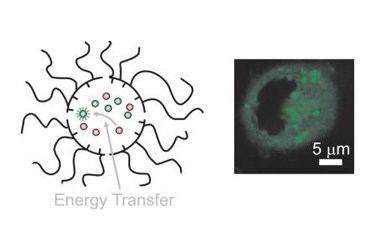Nanosubmarines To Deliver Drugs To Living Cells
By Joel Lindsey

Researchers at the University of Miami have constructed nanoparticles designed to self-assemble and interact with other particles in such a way that could make them ideal for transporting drugs to specifically targeted cells.
“The ability to deliver distinct species inside cells independently and force them to interact, exclusively in the intracellular environment, can evolve into a valuable strategy to activate drugs inside cells,” Francisco Raymo, a professor of chemistry at the University of Miami, said in a press release. “The size of these nanoparticles, their dynamic character, and the fact that the reactions take place under normal biological conditions (at ambient temperature and neutral environment) makes these nanoparticles an ideal vehicle for the controlled activation of therapeutics, directly inside the cells.”
The tiny particles — 15 nanometers in diameter — have been nicknamed “nanosubmarines” for their ability to navigate the watery environments surrounding living cells.
In early tests, these nanosubmarines could be stimulated to self-assemble around complementary “guest molecules,” effectively trapping them within the tiny nanostructures. Because the nanosubmarines are built out of amphiphilic polymers, the water-insoluble interiors of the structures hold the guest molecules safely intact, while their water-soluble exteriors allowed them to move effectively through liquid environments and into living cells.
When the nanoparticles interacted with another cell, researchers were able to manipulate the weak noncovalent bonds of the nanosubmarines and force them to release their guest molecules inside the cell.
Their ability to carry substances through aqueous environments and their ability to release guest molecules at precise locations could make the nanosubmarines effective vehicles for transporting drugs throughout the human body and activating them at particular target sites.
“Once inside a living cell, the particles mix and exchange their cargo. This interaction enables the energy transfer between the internalized molecules,” said Raymo. “If the complementary energy donors and acceptors are loaded separately and sequentially, the transfer of energy between them occurs exclusively within the intracellular space.”
Results from early lab tests using the new nanosubmarines were published recently in the Journal of the American Chemical Society.
These tests were conducted in cell cultures and focused primarily on instigating energy transfers between the nanosubmarines and cells, rather than the chemical reactions that could actually one day release and activate drugs within a human cell. Researchers hope to move the project toward such an application, and plan to test the nanoparticles in a bloodstream at some point in the future.
Image credit: Francisco Raymo, professor of Chemistry and director of the laboratory for molecular photonics, at the University of Miami College of Arts and Sciences
